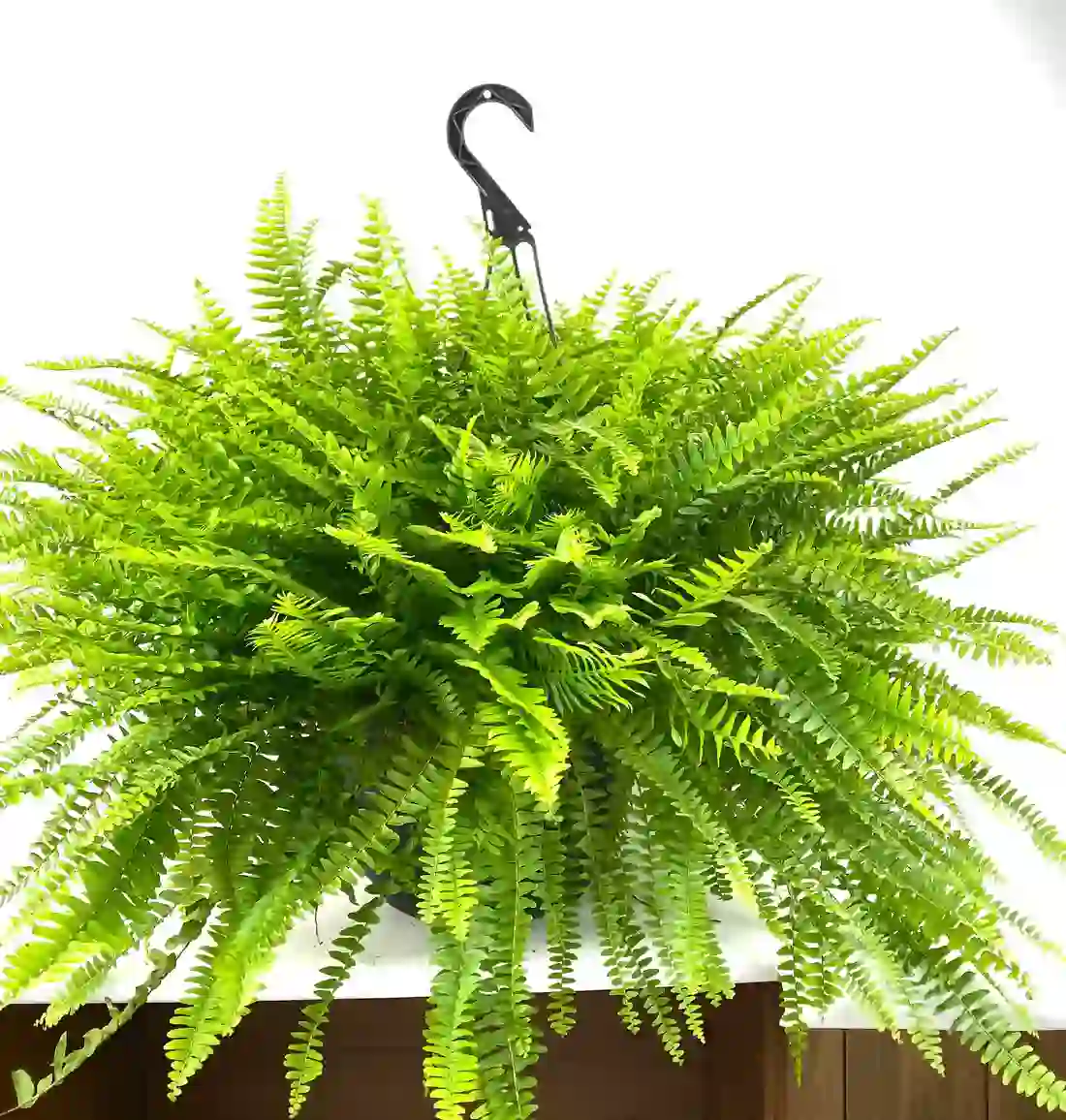If you are looking for an easy and effective way to brighten up your indoor space, look no further than the hanging Boston Fern. Not only does it add a natural touch to your decor, but it also has air-purifying capabilities, making it a healthy addition to your home.
Growing a hanging Boston Fern might seem intimidating at first but with the right care and attention, it can thrive indoors and become a stunning addition to any room. Here’s all you need to know about growing and caring for a hanging Boston Fern.
Key Takeaways:
- A hanging Boston Fern is an easy and effective way to add a touch of natural beauty to your indoor space.
- These plants have air-purifying capabilities, making them a healthy addition to your home.
- With the right care and attention, a hanging Boston Fern can thrive indoors and become a stunning addition to any room.
Why Choose a Hanging Boston Fern for Your Indoor Space?
When it comes to adding greenery to your indoor space, there’s no better option than hanging plants, especially the hanging Boston Fern. Not only do they add a touch of elegance with their gracefully arching fronds, but they also purify the air, making your home feel fresher and more vibrant.
Of all the indoor hanging plants available, the Boston Fern stands out for many reasons. Firstly, it’s incredibly versatile and can thrive in a wide range of temperatures and humidity levels. Secondly, it’s a low-maintenance plant that’s easy to care for, even for those who are new to indoor gardening. Finally, the Boston Fern is known for its air-cleaning properties, making it an excellent choice for anyone looking to improve indoor air quality.
Another reason to choose the hanging Boston Fern for your indoor space is that it adds a unique aesthetic appeal. With its lush green foliage and elegant arching fronds, the fern can brighten up any dull corner of your home. Whether you’re looking to add a touch of nature to your living room, bedroom, or bathroom, the Boston Fern can create a calming and peaceful ambience.
Overall, the hanging Boston Fern is one of the best hanging plants for indoors, offering a range of benefits from its air-purifying capabilities to its easy care. Whether you’re a seasoned indoor gardener or a beginner, this plant is a great addition to any home.

How to Care for Hanging Boston Ferns
Hanging Boston Ferns are easy to care for and can thrive indoors if provided with the right environment. Proper care can ensure that your fern stays healthy and vibrant for years to come. Here are some tips:
1. Watering Frequency
Hanging Boston Ferns prefer evenly moist soil, but they don’t like to sit in water. It is essential to water them regularly, especially during hot and dry weather. Check the soil every two or three days, and water it when the top inch feels dry to the touch. When you water your fern, make sure to water it thoroughly, allowing the water to drain out of the bottom of the pot.
2. Light Requirements
Hanging Boston Ferns prefer bright, indirect sunlight. Direct sunlight can scorch the fronds, and too little light can cause them to become leggy and weak. Keep your fern near a window that receives filtered light, or in a well-lit room with lots of natural light.
3. Ideal Temperature and Humidity Levels
Hanging Boston Ferns thrive in temperatures between 60°F and 75°F. They also prefer high humidity levels, so it is essential to keep them away from drafts and air conditioning vents. You can increase humidity around your fern by misting it regularly or placing a tray of water near it.
4. Fertilizing, Pruning, and Repotting
Feed your Hanging Boston Fern with a balanced, water-soluble fertilizer every four to six weeks during the growing season. Prune any yellow or damaged fronds regularly to keep the plant looking healthy. You can also repot your fern every two years or so to ensure that it has adequate growing space.
5. Additional Tips
- Make sure to choose a potting mix that drains well to prevent waterlogging.
- Consider placing your fern in a bathroom with high humidity levels, or use a humidifier to increase the moisture in the air.
- Avoid placing your fern near vents, heating sources, or on top of radiators.
- Don’t let your fern dry out completely, as it will cause the fronds to turn brown and brittle.
By following these simple care tips, you can enjoy a beautiful and thriving Hanging Boston Fern in your indoor space.
Choosing the Right Location to Hang Your Boston Fern
When it comes to hanging your Boston Fern, choosing the right location is crucial. This houseplant thrives in bright, indirect light and temperatures between 60°F and 75°F. Avoid direct sunlight and cold drafts, as these can damage the delicate fronds.
If you’re unsure where to hang your fern, consider placing it in a room with plenty of natural light, such as a north-facing window. You can also hang it in a bathroom where humidity levels are higher. This can help to keep the fronds looking lush and green.
Another important factor to consider is the weight of the hanging basket. Ensure that the hook or anchor you use can support the weight of the fern and the potting soil.
Avoiding Direct Sunlight
Direct sunlight can scorch the fronds of your Boston Fern. If you notice that your fern is getting too much sun, try moving it to a shadier spot or using a sheer curtain to filter the light.
Protecting from Drafts
Boston Ferns are sensitive to cold drafts, which can dry out the fronds and cause them to drop. Avoid hanging your fern near windows or doors that are frequently opened and closed. If you notice that your fern is getting too much air movement, try moving it to a more sheltered location.

Creating an Aesthetic Display with Hanging Boston Ferns
While hanging Boston Ferns are beautiful on their own, there are several creative ways to display them in your indoor space. Adding a touch of greenery to your home can do wonders for brightening up your space. Here are some suggestions for creating an aesthetically pleasing arrangement with your indoor hanging plants.
Using Hanging Baskets
Hanging baskets are a classic and practical choice for displaying hanging Boston Ferns. They come in various styles and materials, such as woven baskets, wire baskets, and plastic containers. Opt for a basket that complements the decor of your room and has proper drainage to ensure your fern stays healthy.
Macrame Hangers
If you’re looking for a bohemian touch to your decor, macrame hangers are an excellent choice. They are made of knotted cords that provide a rustic feel to your hanging Boston Ferns. Macrame plant hangers are available in a range of colors and styles, adding an element of personality to your space.
Wall-Mounted Planters
Wall-mounted planters are ideal for those who want to add some greenery to their walls and free up floor space. They come in various shapes, sizes, and materials such as wood, metal, and ceramic. Wall-mounted planters are perfect for creating an eye-catching display with your indoor hanging plants and can be arranged in various groupings and patterns to suit your style.
Pairing with Other Indoor Hanging Plants
Pairing your hanging Boston Ferns with other indoor hanging plants can create an interesting and visually appealing display. Consider pairing your fern with other plants that have contrasting textures and colors. Ferns, pothos, and spider plants are all great choices for creating an indoor display that is both lush and harmonious.
With these creative suggestions, your hanging Boston Fern can enhance your indoor space and create a fresh, vibrant atmosphere.
Where to Find Hanging Boston Ferns for Sale
If you’re looking to purchase a hanging Boston Fern for your indoor space, there are several options available. Local nurseries and garden centers often carry a variety of ferns, including Boston Ferns, in different sizes and styles. It’s recommended to visit the store and inspect the plants before purchasing to ensure they are healthy and free of pests.
Online retailers, such as Amazon and Etsy, also offer a wide selection of hanging Boston Ferns for sale. When purchasing online, be sure to read the seller’s care instructions and shipping policies to ensure your fern arrives in good condition.
It’s important to note that while Boston Ferns are relatively easy to care for, they do require specific conditions to thrive. Be sure to familiarize yourself with the plant’s care guide before purchasing to ensure you can provide the appropriate environment for your fern to flourish.
Hanging Boston Ferns in Low Light Conditions
Hanging Boston Ferns are a great addition to any indoor space due to their elegant fronds and air-purifying capabilities. However, some indoor areas may have limited natural light, making it challenging to grow hanging plants.
Can Hanging Boston Ferns Survive in Low Light Conditions?
Yes, they can! Hanging Boston Ferns are relatively adaptable and can adjust to low light conditions. While they prefer bright, indirect light, they can still grow and thrive in spaces with limited access to natural light.
How to Provide Adequate Lighting for Hanging Boston Ferns in Low Light Conditions
If your space has limited natural light, you can provide additional light by using artificial grow lights. LED grow lights are a popular choice as they consume less energy and emit less heat than other types of grow lights.
Before installing grow lights, you should note that Hanging Boston Ferns don’t like direct sunlight. Therefore, ensure that the grow lights are placed close to the ferns and angled away from the plant to avoid direct heat.
How to Ensure Your Hanging Boston Ferns Thrive in Low Light Conditions
Here are some tips to help your Hanging Boston Ferns thrive in low light conditions:
- Water your ferns when the top inch of soil is dry. Overwatering can lead to root rot.
- Use a humidifier or place a tray of water near the ferns to increase humidity.
- Fertilize your ferns every two to four weeks with a balanced liquid fertilizer to keep them healthy.
- Prune your ferns regularly to remove dead or damaged fronds.
In conclusion, hanging Boston Ferns are hardy plants and can thrive in low light conditions with adequate care and attention. By following these tips, you can ensure your ferns remain healthy and vibrant, even in spaces with limited natural light.













Comments are closed.